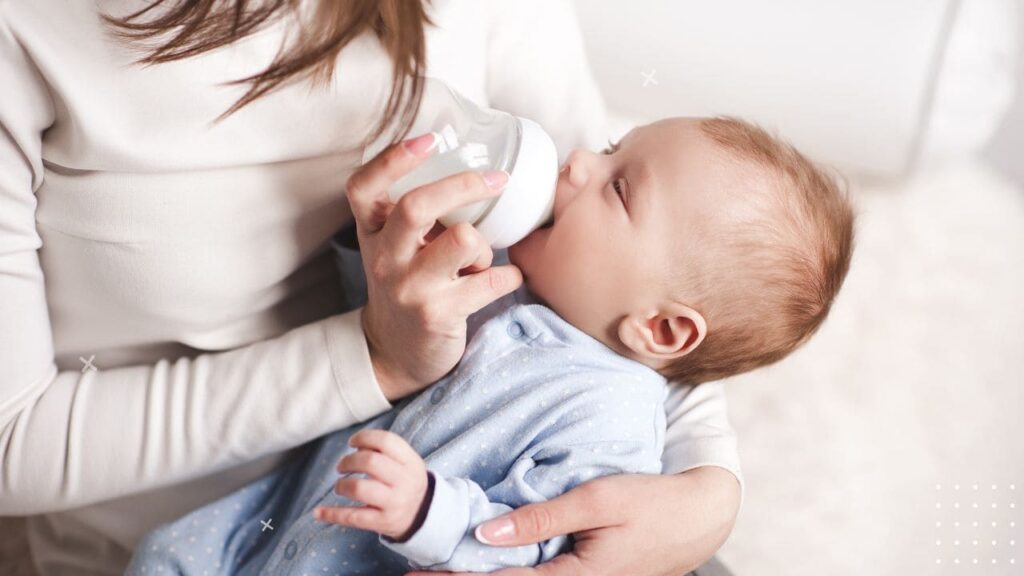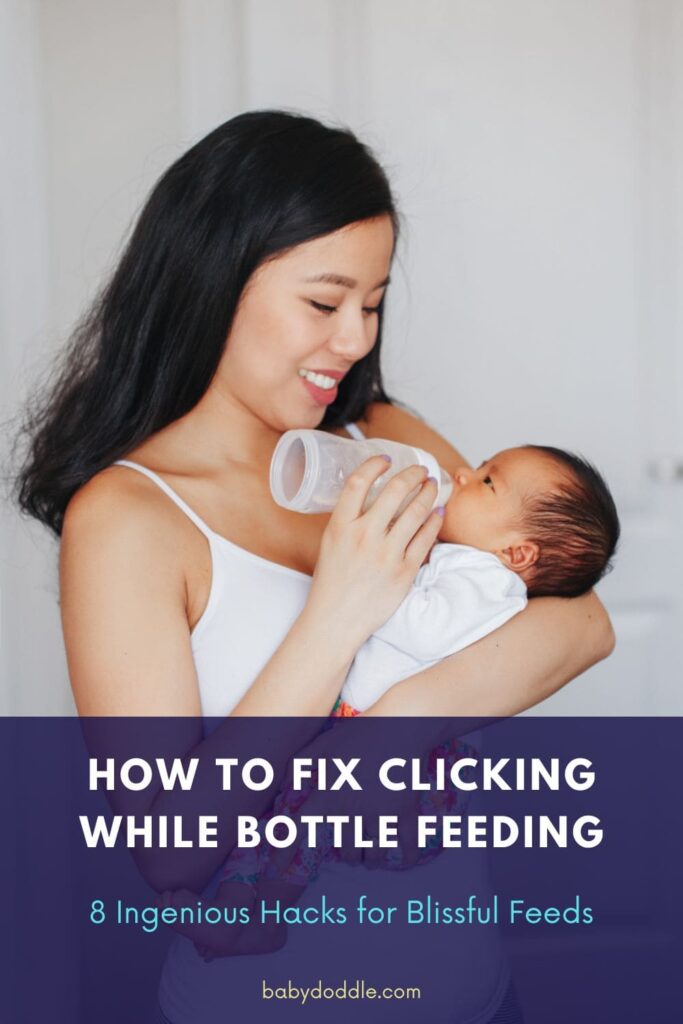The gentle sound of a baby suckling is music to a parent’s ears. But what happens when that soothing rhythm is interrupted by clicking noises? If you’ve noticed your little one making clicking sounds while bottle feeding, you’re not alone. This common issue can leave parents feeling frustrated and concerned about their baby’s comfort and nutrition.
In this comprehensive guide, we’ll dive deep into the world of clicking while bottle feeding. We’ll explore the causes, potential concerns, and most importantly, provide you with 8 ingenious hacks to transform those noisy feeds into blissful bonding moments. Whether you’re a first-time parent or a seasoned pro, these tips will help you navigate the choppy waters of clicking and sail smoothly towards feeding success.
Understanding Clicking While Feeding
Before we jump into our problem-solving toolbox, let’s take a moment to understand what’s really going on when your baby makes those clicking sounds. Imagine trying to drink from a straw that keeps losing its seal – that’s essentially what’s happening when your baby clicks during feeding.
Clicking occurs when there’s a break in the seal between your baby’s mouth and the bottle nipple. This break allows air to enter, creating that distinctive clicking noise. While it might seem like a minor inconvenience, clicking can lead to several issues:
- Increased air intake, potentially causing gas and discomfort
- Inefficient feeding, as your baby may not be getting enough milk
- Frustration for both baby and parent, potentially turning feeding time into a stressful experience
Now that we know what we’re dealing with, let’s explore the various causes of clicking while bottle feeding.

Causes of Clicking While Feeding
Understanding the root cause of clicking is crucial in finding the right solution. Here’s a comprehensive list of potential culprits:
- Poor positioning/latch: Just like in breastfeeding, the way your baby latches onto the bottle can make all the difference.
- Strong, forceful letdown: If you’re using expressed breast milk, a powerful letdown can overwhelm your baby, leading to clicking.
- Engorgement: For breastfeeding moms who also bottle feed, engorged breasts can affect milk flow and latch.
- Poor tongue mobility/function: Issues like tongue tie can restrict your baby’s ability to create a proper seal.
- Inability to maintain a seal: Weak muscles or a lip tie might make it difficult for your baby to keep a consistent latch.
- Weakness of the tongue: A weak tongue can struggle to create the necessary suction for efficient feeding.
- High arched or bubble palate: The shape of your baby’s palate can affect their ability to feed effectively.
- Submucosal cleft: This hidden type of cleft palate can cause feeding difficulties.
- Ear infections: Discomfort from ear infections can affect your baby’s sucking patterns.
- Thrush: This oral yeast infection can make feeding uncomfortable, leading to clicking.
- Body tension or physical conditions: Issues like torticollis can affect your baby’s feeding position and comfort.
Understanding these potential causes is the first step in addressing clicking while bottle feeding. Now, let’s dive into some practical solutions.
8 Ingenious Hacks to Fix Clicking While Bottle Feeding
Hack #1: Perfect the Latch
A proper latch is the foundation of successful bottle feeding. Here’s how to achieve it:
- Ensure your baby’s lips are flanged outward, creating a wide seal around the bottle nipple.
- The nipple should be deep in your baby’s mouth, almost to the point where the nipple base meets the bottle.
- Your baby’s chin should be touching the breast of the bottle, with their nose clear.
Signs of a good latch include:
- Rhythmic sucking and swallowing
- Relaxed body and hands
- Minimal milk leakage from the corners of the mouth
If you’re still struggling, try gently stroking your baby’s cheek or lips with the nipple to encourage a wide-open mouth before latching.
Hack #2: Choose the Right Nipple Flow
The speed at which milk flows from the bottle can significantly impact clicking. Here’s a general guide to nipple flows:
| Age | Recommended Nipple Flow |
|---|---|
| 0-3 months | Slow flow |
| 3-6 months | Medium flow |
| 6+ months | Fast flow |
Remember, these are just guidelines. Your baby might prefer a different flow rate. Signs that you need to adjust the flow include:
- Clicking or gasping during feeding (flow too fast)
- Frustrated sucking or falling asleep at the bottle (flow too slow)
Experiment with different nipple flows to find the perfect match for your baby’s sucking strength and preference.
Hack #3: Master the Paced Bottle Feeding Technique
Paced bottle feeding mimics breastfeeding, giving your baby more control over milk flow. Here’s how to do it:
- Hold your baby in a more upright position, supporting their head and neck.
- Keep the bottle horizontal, with just enough tilt to fill the nipple with milk.
- Allow your baby to draw the nipple into their mouth, rather than pushing it in.
- Let your baby pause every 20-30 seconds, just as they would during breastfeeding.
This technique can reduce clicking by preventing milk from flowing too quickly and overwhelming your baby.

Hack #4: Experiment with Bottle Angles
The angle at which you hold the bottle can make a big difference. Try these variations:
- Slightly tilt the bottle so that the nipple and neck are always filled with milk.
- Experiment with a more upright feeding position, which can help reduce air intake.
- Consider specialized anti-colic bottles that are designed to be held at specific angles.
Remember, every baby is different. What works for one might not work for another, so don’t be afraid to try different angles until you find what works best for your little one.
Hack #5: Burp Frequently
Burping isn’t just for after feeding – it can be a game-changer during feeds too. Here’s why:
- Regular burping helps release air bubbles that can cause clicking and discomfort.
- It gives your baby a chance to reset their latch, potentially improving their seal on the nipple.
Try burping your baby every 2-3 ounces, or if you notice increased clicking or fussiness. Here are some effective burping techniques:
- Over-the-shoulder burp
- Sitting on your lap, supporting the chest and head
- Laying across your lap, gently patting or rubbing the back
Hack #6: Try Anti-Colic Bottles
Anti-colic bottles are designed to reduce air intake during feeding, which can help minimize clicking. Here’s what to look for:
- Vented designs that allow air to enter the bottle without passing through the milk
- Angled bottles that keep the nipple and neck filled with milk
- Special nipple designs that mimic the breast and promote a better latch
Popular anti-colic bottle options include:
| Brand | Key Features |
|---|---|
| Dr. Brown’s | Internal vent system |
| Philips Avent | Anti-colic valve integrated into the nipple |
| MAM | Self-sterilizing design with vented base |
| Tommee Tippee | Breast-like nipple with anti-colic vents |
Remember, while these bottles can be helpful, they’re not a guaranteed fix. It may take some trial and error to find the right bottle for your baby.
Hack #7: Check for Tongue or Lip Ties
Sometimes, clicking persists because of physical restrictions in your baby’s mouth. Tongue and lip ties occur when the thin piece of tissue connecting the tongue to the bottom of the mouth (tongue tie) or the upper lip to the gum (lip tie) is too short or tight.
Signs of tongue or lip ties include:
- Difficulty latching or staying latched
- Clicking sounds during feeding
- Gassy or colicky behavior
- Poor weight gain
If you suspect a tie, consult with a pediatric dentist or an ENT specialist. They can diagnose and, if necessary, perform a simple procedure to release the tie.
Hack #8: Practice Proper Bottle Preparation
The way you prepare your baby’s bottle can impact clicking. Here are some tips:
For formula:
- Use the scoop that comes with the formula to ensure proper measurements.
- Add water to the bottle first, then formula.
- Gently swirl the bottle to mix – don’t shake vigorously, as this can create air bubbles.
For breast milk:
- If frozen, thaw in the refrigerator or under cool running water.
- Gently swirl to mix any separated fat – again, avoid shaking.
When filling bottles:
- Tilt the bottle slightly while pouring to minimize air bubbles.
- If bubbles form, let the bottle sit for a few minutes before feeding to allow them to dissipate.
The Impact of Bottle Design on Clicking
When it comes to reducing clicking during bottle feeding, the design of the bottle itself can play a crucial role. Let’s dive deeper into how different bottle features can affect your baby’s feeding experience:
Nipple Shape and Material
The nipple is perhaps the most critical component of a bottle when it comes to preventing clicking. Here’s what to look for:
- Wide-base nipples: These mimic the shape of a breast, encouraging a wider latch that can help reduce clicking.
- Soft silicone: A softer nipple can be easier for your baby to compress, potentially reducing the likelihood of breaking suction.
- Textured nipples: Some bottles feature nipples with a textured surface, which can help your baby maintain a good latch.
- Vented nipples: These have tiny holes or slits that allow air to enter the bottle without going through the milk, potentially reducing clicking and colic.
Bottle Venting Systems
Many modern bottles come with built-in venting systems designed to reduce air intake during feeding:
- Internal vent tubes: Bottles like Dr. Brown’s use a long tube that runs from the nipple to the bottom of the bottle, allowing air to bypass the milk entirely.
- Bottom vents: Some bottles, like MAM, feature vents in the base of the bottle to allow air in without disturbing the milk flow.
- Collapsible bags: Bottles that use disposable liners collapse as the baby feeds, potentially reducing air intake.
Bottle Shape
The shape of the bottle can also influence feeding dynamics:
- Angled bottles: These are designed to be held at an angle that keeps the nipple and neck filled with milk, potentially reducing air intake.
- Wide-neck bottles: These often pair with wide-base nipples and can encourage a better latch.
- Ergonomic shapes: Some bottles are designed with curves or indentations that make them easier for babies to hold, potentially leading to more relaxed feeding sessions.
Remember, what works best can vary from baby to baby. Don’t be afraid to experiment with different bottle designs to find the one that helps reduce clicking for your little one.

The Role of Feeding Position in Reducing Clicking
The way you position your baby during bottle feeding can significantly impact their ability to feed efficiently and reduce clicking. Let’s explore some optimal feeding positions and their benefits:
1. Semi-Upright Position
This is often considered the ideal position for bottle feeding:
- Hold your baby at a 45-degree angle, supporting their head and neck.
- Ensure their head is higher than their stomach.
- This position can help reduce ear infections and reflux while promoting better digestion.
2. Side-Lying Position
This position mimics breastfeeding and can be particularly helpful for babies who are fed both breast and bottle:
- Lay your baby on their side, supporting their head and neck.
- Hold the bottle horizontally, allowing the baby to control the milk flow.
- This can help prevent overfeeding and reduce clicking.
3. Elevated Cradle Hold
Similar to the cradle hold used in breastfeeding:
- Support your baby’s head in the crook of your elbow, with their body along your forearm.
- Elevate your arm slightly so the baby is at an incline.
- This position allows for good eye contact and bonding while feeding.
4. Upright Seated Position
For older babies with good head control:
- Sit your baby on your lap, supporting their back and head if needed.
- Hold the bottle at chest level.
- This position can be helpful for babies with reflux.
Tips for Any Position
Regardless of the position you choose, keep these tips in mind:
- Keep the bottle horizontal: This slows milk flow and reduces air intake.
- Switch sides: Alternate which arm you use to feed, promoting equal eye muscle development.
- Maintain eye contact: This supports bonding and allows you to watch for feeding cues.
- Ensure comfort: Both you and your baby should be comfortable throughout the feeding.
Remember, the best position is one that works for both you and your baby. Don’t hesitate to adjust and experiment to find what reduces clicking and makes feeding a pleasant experience for everyone involved.
Understanding Baby Tongue Strength
A strong, coordinated tongue is crucial for efficient feeding. Here’s why:
- The tongue creates the necessary suction for drawing milk from the bottle.
- It helps form a proper seal around the nipple, preventing air intake.
- A strong tongue aids in the swallowing process.
Signs that your baby might have weak tongue strength include:
- Difficulty latching or maintaining a latch
- Fatigue during feeding
- Excessive drooling
- Speech delays later in development
Ways to Strengthen Baby’s Tongue
If you suspect your baby has weak tongue strength, try these exercises:
- Tongue Exercises: Gently stroke your baby’s tongue from back to front with your clean finger. This can help increase awareness and strength.
- Facial Massage: Softly massage your baby’s cheeks in a circular motion. This can help activate facial muscles used in feeding.
- Tummy Time: This classic activity isn’t just for motor development – it also strengthens neck and facial muscles used in feeding.
- Oral Play: Offer safe toys of various textures for your baby to explore with their mouth. This helps develop oral motor skills.
Remember, if you’re concerned about your baby’s tongue strength, consult with a pediatric speech-language pathologist or a feeding specialist for professional guidance.
Oral Development Teethers
Teethers aren’t just for soothing sore gums – they can also play a crucial role in oral development and potentially help with feeding issues. Here’s how:
- Teethers encourage exploration of different textures and movements in the mouth.
- They can help strengthen jaw and facial muscles used in feeding.
- Some teethers are designed specifically to promote tongue movement and strength.
Innobaby’s star teethers, for example, are great for more than just teething pain. Their unique shape and texture can help stimulate oral motor development, potentially aiding in more efficient feeding and reducing issues like clicking.
Troubleshooting Persistent Clicking
If you’ve tried all these hacks and clicking persists, don’t lose hope. Here are some next steps:
- Keep a feeding diary: Note when clicking occurs, how often, and any other symptoms. This can help identify patterns.
- Video a feeding: Sometimes, healthcare providers can spot issues you might miss.
- Consult a lactation consultant: Even if you’re bottle feeding, these experts can provide valuable insights into feeding mechanics.
- Visit your pediatrician: They can check for any underlying medical issues and provide personalized advice.
- Consider a feeding evaluation: A speech-language pathologist or occupational therapist specializing in feeding can offer in-depth assessment and targeted strategies.
Remember, every baby is unique. What works for one might not work for another, so patience and persistence are key.
Conclusion
Clicking while bottle feeding can be frustrating, but it’s a solvable problem. By understanding the causes and implementing these 8 ingenious hacks, you’re well on your way to more peaceful, efficient feeding sessions.
Remember, the journey of parenting is full of challenges and triumphs. Feeding issues are just one small bump in the road. With patience, persistence, and the right techniques, you’ll soon be enjoying those precious feeding moments without the soundtrack of clicks.
Don’t hesitate to reach out to healthcare providers or feeding specialists if you need additional support. You’re doing a great job, and your baby is lucky to have such a dedicated caregiver. Here’s to happy, click-free feeding!
FAQ – How to Fix Clicking While Bottle Feeding
Is clicking always a problem during bottle feeding?
While occasional clicking isn’t usually a cause for concern, persistent clicking can indicate feeding difficulties. It may lead to increased air intake, which can cause gas, discomfort, and inefficient feeding. If clicking is frequent or accompanied by other issues like fussiness or poor weight gain, it’s worth addressing.
Can clicking while bottle feeding cause long-term issues?
Prolonged clicking during feeding can potentially lead to several issues. These may include chronic gas and colic, which can disturb your baby’s sleep and comfort. In some cases, it might affect weight gain if the baby isn’t able to feed efficiently. Additionally, the habit of improper sucking might persist, potentially affecting oral development. However, most clicking issues can be resolved with proper techniques and, if necessary, professional guidance.
How can I tell if my baby’s clicking is due to a tongue tie?
Identifying a tongue tie can be tricky and often requires professional assessment. However, some signs that clicking might be due to a tongue tie include:
- Difficulty latching or staying latched to the bottle
- A heart-shaped or forked appearance of the tongue when it’s extended
- Inability to stick the tongue out past the lower lip
- A visible tight band of tissue under the tongue
- Persistent clicking despite trying various feeding techniques If you suspect a tongue tie, it’s best to consult with a pediatric dentist, lactation consultant, or ENT specialist for a proper diagnosis.
Are there any bottle designs specifically aimed at reducing clicking?
Yes, several bottle designs aim to reduce clicking and other feeding issues. Anti-colic bottles often have features that can help:
- Vented systems: Bottles like Dr. Brown’s have internal venting systems that allow air to flow into the bottle without passing through the milk.
- Angled designs: Bottles shaped at an angle help keep the nipple and neck filled with milk, reducing air intake.
- Specialized nipples: Some bottles have nipples designed to mimic the breast, promoting a better latch.
- Variable flow systems: Bottles that allow you to adjust the flow rate can help match your baby’s sucking strength and preference. Remember, while these designs can be helpful, they’re not guaranteed solutions. It may take some trial and error to find the right bottle for your baby.
How can I differentiate between clicking caused by feeding issues and normal feeding sounds?
Distinguishing between problematic clicking and normal feeding sounds can be challenging, but here are some guidelines:
Normal feeding sounds:
- Soft, rhythmic suckling noises
- Occasional gentle swallowing sounds
- Quiet breathing through the nose
Problematic clicking:
- Loud, persistent clicking or smacking sounds
- Gulping or gasping noises
- Frequent breaks in sucking rhythm
- Milk leaking from the corners of the mouth
If you’re unsure, consider recording a feeding session and showing it to your pediatrician or a lactation consultant. They can help determine if the sounds you’re hearing are cause for concern or just part of your baby’s unique feeding style. Remember, every baby is different, and what’s normal for one might not be for another. Trust your instincts – if you feel something isn’t right, it’s always worth getting a professional opinion.












